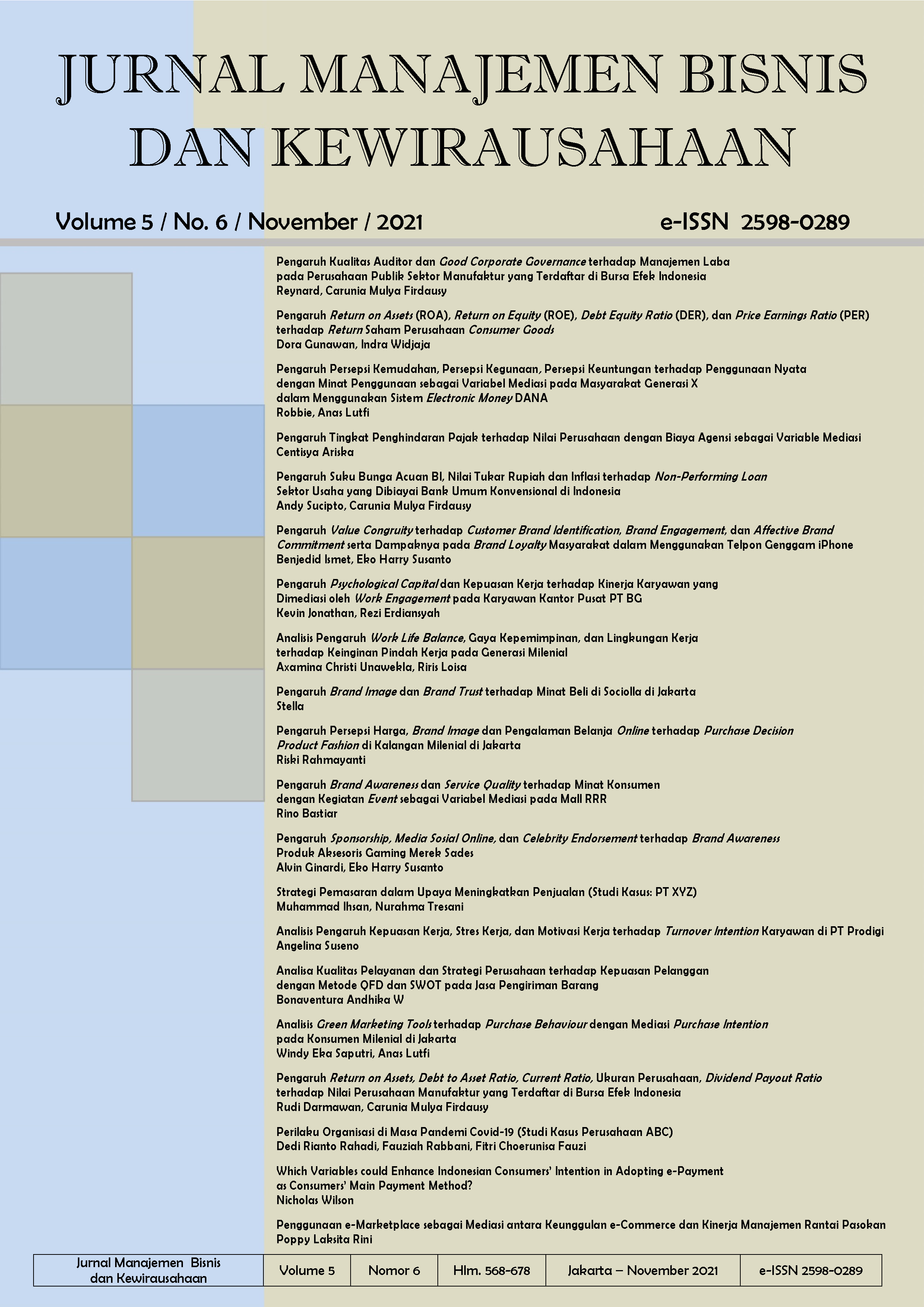Analisis Green Marketing Tools terhadap Purchase Behaviour dengan Mediasi Purchase Intention pada Konsumen Milenial di Jakarta
Main Article Content
Abstract
This study aims to explain green marketing tools that influence purchase intention and purchase behavior in Jakarta to purchase Ades. The instrument of this research is a questionnaire distributed to 522 millennials in Jakarta. Data collected was analyzed using SmartPLS analysis. The results of this study indicate that there is an influence of ecolabel, ecobrand, environmental advertisement on purchase intention. In addition, there is an influence on purchase intention and purchase behavior. Furthermore, the results of the study indicate that purchase intention mediates the relationship between ecobrand and environmental advertisement towards purchase behavior.
Penelitian ini bertujuan untuk menjelaskan green marketing tools yang purchase intention dan purchase behaviour di Jakarta pada pembelian Ades. Instrumen penelitian ini berupa kuesioner yang disebarkan kepada 522 milenial di Jakarta. Data yang terkumpul dianalisis menggunakan SmartPLS. Hasil penelitian ini menunjukkan bahwa terdapat pengaruh eco-label, eco-brand, dan environment advertisement terhadap purchase intention. Selain itu terdapat pengaruh purchase intention dan purchase behaviour. Hasil penelitian menunjukkan bahwa purchase intention memediasi hubungan antara eco-brand dan environmental advertisement terhadap purchase behaviour.
Article Details
This work is licensed under a Jurnal Manajemen Bisnis dan Kewirausahaan Creative Commons Attribution-ShareAlike 4.0 International License.
References
Aggrawal, A. (2010). Factors affecting green marketing in India: A study of metro consumers. Padmashree Dr. D. Y. Patil University.
Ahmad, H., Shah, I. A., & Ahmad, K. (2010). Factors in environmental advertising influencing consumer’s purchase intention. European Journal of Scientific Research, 48(2), 217–226.
Belch, G., & Belch, M. (2011). Advertising and promotion: An integrated marketing communications perspective (6th ed.). McGraw-Hill.
Bozowsky, E., & Mizuno, H. (2004). Introduction to ecolabelling. Global Ecolabelling Network (GEN) Information Paper.
Bruce, C., & Laroiya, A. (2007). The production of eco-labels. Environmental and Resource Economics, 36(3), 275–293. https://doi.org/10.1007/s10640-006-9028-9
Budiarti, I., Susianto, Y., P, W. P. A., Ayuni, S., Reagan, H. A., Larasaty, P., Setiyawati, N., Pratiwi, A. I., & Saputri, V. G. (2018). Statistik gender tematik: Profil generasi milenial Indonesia (Badan Pusat Statistik (ed.)). Kementerian Pemberdayaan Perempuan dan Perlindungan Anak.
Chekima, B., Chekima, S., Syed Khalid Wafa, S. A. W., Igaua, O. A., & Sondoh, S. L. (2016). Sustainable consumption: The effects of knowledge, cultural values, environmental advertising, and demographics. International Journal of Sustainable Development and World Ecology, 23(2), 210–220. https://doi.org/10.1080/13504509.2015.1114043
Cialdini, R. B. (2001). Influence: Science and practice. Pearson Education, Inc.
D’Souza, C., Taghian, M., & Lamb, P. (2006). An empirical study on the influence of environmental labels on consumers. Corporate Communications, 11(2), 162–173. https://doi.org/10.1108/13563280610661697
Delafrooz, N., Taleghani, M., & Nouri, B. (2014). Effect of green marketing on consumer purchase behavior. QScience Connect, 2014(5), 9. https://doi.org/10.5339/connect.2014.5
Delmas, M. A., & Pekovic, S. (2013). Environmental standards and labor productivity: Understanding the mechanisms that sustain sustainability. Journal of Organizational Behavior, 34(2), 230–252. https://doi.org/10.1002/job.1827
Durmaz, Y., & Sevil, Z. N. (2011). A theoretical approach to concept of green marketing. Interdisciplinary Journal of Contemporary Research in Business, 3(2), 1808–1814.
Fraj, E., & Martinez, E. (2006). Influence of personality on ecological consumer behaviour. Journal of Consumer Behaviour, 5(3), 167–181. https://doi.org/10.1002/cb.169
Kotler, P., & Armstrong, G. (2008). Prinsip-prinsip pemasaran (12th ed.). Erlangga.
Kotler, P., & Keller, K. L. (2012). Manajemen pemasaran (12th ed.). Erlangga.
Laroche, M., Bergeron, J., & Barbaro-Forleo, G. (2001). Targeting consumers who are willing to pay more for environmentally friendly products. Journal of Consumer Marketing, 18(6), 503–520. https://doi.org/10.1108/EUM0000000006155
Leonidou, L. C., Leonidou, C. N., Palihawadana, D., & Hultman, M. (2011). Evaluating the green advertising practices of international firms: A trend analysis. Studies in Economics and Finance, 28(1), 6–33. https://doi.org/10.1108/02651331111107080
Ling, K. C., Chai, L. T., & Piew, T. H. (2010). The effects of shopping orientations, online trust and prior online purchase experience toward customers’ online purchase intention. International Business Research, 3(3), 63. https://doi.org/10.5539/ibr.v3n3p63
Novalius, F. (2019). Menteri Rini: Milenial harus menjaga dan merawat lingkungan. Okefinance. https://economy.okezone.com/read/2019/01/31/320/2012048/menteri-rini-milenial-harus-menjaga-dan-merawat-lingkungan
Popovici, V., & Muhcina, S. (2015). An overview of millennials’ coming of age. The emergence of generation Y and its underlying and consequential socio-economic aspects. Ovidius University Annals, Series Economic Sciences, 15(1), 341–346. https://stec.univ-ovidius.ro/html/anale/RO/2015/ANALE vol 15_issue_1.pdf
Rahbar, E., & Wahid, N. A. (2011). Investigation of green marketing tools’ effect on consumers’ purchase behavior. Business Strategy Series, 12(2), 73–83. https://doi.org/10.1108/17515631111114877
Rex, E., & Baumann, H. (2007). Beyond ecolabels: What green marketing can learn from conventional marketing. Journal of Cleaner Production, 15(6), 567–576. https://doi.org/10.1016/j.jclepro.2006.05.013
Ridwan, M., Fauzi, A., & Bafadhal, A. S. (2017). Pengaruh green product, green advertising dan green brand terhadap keputusan pembelian (Survei pada mahasiswa jurusan Ilmu Administrasi Bisnis Angkatan 2013/2014 dan 2014/2015 Fakultas Ilmu Administrasi Universitas Brawijaya konsumen air minum kemasan mer. Jurnal Administrasi Bisnis (JAB).
Rios, F. J. M., Luque Martínez, T., Moreno, F. F., & Soriano, P. C. (2006). Improving attitudes toward brands with environmental associations: An experimental approach. Journal of Consumer Marketing, 23(1), 26–33. https://doi.org/10.1108/07363760610641136
Sarkar, A. N. (2012). Green branding and eco-innovations for evolving a sustainable green marketing strategy. Asia-Pacific Journal of Management Research and Innovation, 8(1), 39–58. https://doi.org/10.1177/2319510x1200800106
Sekaran, U., & Bougie, R. (2013). Research methods for business: A skill building approach (5th ed.). John Wiley & Sons.
Shah, S. S. H., Aziz, J., Jaffari, A. R., Waris, S., Ejaz, W., Fatima, M., & Sherazi, S. K. (2012). The impact of brands on consumer purchase intentions. Asian Journal of Business Management, 4(2), 105–110. https://maxwellsci.com/print/ajbm/v4-105-110.pdf
Tan, B. C., & Lau, T. C. (2011). Green purchase behavior: Examining the influence of green environmental attitude, perceived consumer effectiveness and specific green purchase attitude. Australian Journal of Basic and Applied Sciences, 5(8), 559–567. http://ajbasweb.com/old/ajbas/2011/August-2011/559-567.pdf
Teng, L., & Laroche, M. (2007). Building and testing models of consumer purchase intention in competitive and multicultural environments. Journal of Business Research, 60(3), 260–268. https://doi.org/10.1016/j.jbusres.2006.09.028
Woo, A. (2018). Understanding the research on millenial shopping behaviors. Forbes.Com. https://www.forbes.com/sites/forbesagencycouncil/2018/06/04/understanding-the-research-on-millennial-shopping-behaviors/?sh=456eb31c5f7a
Young, M. E., & McCoy, A. W. (2016). Millennials and chocolate product ethics: Saying one thing and doing another. Food Quality and Preference, 49, 42–53. https://doi.org/10.1016/j.foodqual.2015.11.014


